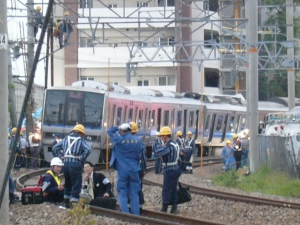Related Research Articles

The Malbone Street wreck, also known as the Brighton Beach Line accident, was a rapid transit railroad accident that occurred on November 1, 1918, on the New York City Subway's BMT Brighton Line in the Flatbush neighborhood of Brooklyn in New York City. A speeding train derailed in the sharply curved tunnel beneath Willink Plaza, the intersection of Flatbush Avenue, Ocean Avenue, and Malbone Street. At least 93 people died, making it the second-deadliest train crash in American history, as well as the deadliest crash in the history of the New York City Subway.

On September 22, 1993, an Amtrak Sunset Limited passenger train derailed on the CSX Transportation Big Bayou Canot Bridge near Mobile, Alabama, United States. It was caused by displacement of a span and deformation of the rails when a tow of heavy barges collided with the rail bridge eight minutes earlier. Forty-seven people were killed and 103 more were injured. To date, it is the deadliest train wreck in both Amtrak's history and Alabama's railway history. It is also the worst rail disaster in the United States since the 1958 Newark Bay rail accident, in which 48 people died.

The 2005 Glendale train crash occurred on January 26, 2005, at 6:03 a.m. PST, when a Metrolink commuter train collided with a sport utility vehicle that had been parked on the tracks by a suicidal man in an industrial area of Glendale, California, just east of the Los Angeles city limits, causing the deaths of 11 people and injuring 177 more. The driver of the car, who had changed his mind shortly before the impact but willingly left his car on the tracks, survived the incident and was charged with eleven counts of murder and one count of arson.

The Amagasaki derailment occurred in Amagasaki, Hyōgo Prefecture, Japan, on 25 April 2005 at 09:19 local time, just after the local rush hour. It occurred when a seven-car commuter train came off the tracks on West Japan Railway Company's Fukuchiyama Line in just before Amagasaki on its way for Dōshisha-mae via the JR Tōzai Line and the Katamachi Line, and the front two cars rammed into an apartment building. The first car slid into the first-floor parking garage and as a result took days to remove, while the second slammed into the corner of the building, being crushed into an L-shape against it by the weight of the remaining cars. Of the roughly 700 passengers on board at the time of the crash, 106 passengers, in addition to the driver, were killed and 562 others injured. Most survivors and witnesses claimed that the train appeared to have been travelling too fast. The incident was Japan's most serious since the 1963 Tsurumi rail accident.

The San Bernardino train disaster, was a combination of two separate but related incidents that occurred in San Bernardino, California, United States: a runaway train derailment on May 12, 1989; and the subsequent failure on May 25, 1989, of the Calnev Pipeline, a petroleum pipeline adjacent to the tracks which was damaged by earth-moving equipment during the crash cleanup.
There have been a number of train accidents on the railway network of Victoria, Australia. Some of these are listed below.
A runaway train is a type of railroad incident in which unattended rolling stock is accidentally allowed to roll onto the main line, a moving train loses enough braking power to be unable to stop in safety, or a train operates at unsafe speeds due to loss of operator control. If the uncontrolled rolling stock derails or hits another train, it will result in a train wreck.

The CSX 8888 incident, also known as the Crazy Eights incident, was a runaway train event involving a CSX Transportation freight train in the U.S. state of Ohio on May 15, 2001. Locomotive #8888, an EMD SD40-2, was pulling a train of 47 cars, including possibly two cars loaded with hazardous chemicals, specifically molten phenol, a substance used in dyes and glues, and ran uncontrolled for just under two hours at up to 51 miles per hour (82 km/h). It was finally halted by a railroad crew in a catch locomotive, which caught up with the runaway train and coupled their locomotive to the rear car.

The 1953 Pennsylvania Railroad train wreck occurred on January 15, 1953, when a passenger and mail train from Boston to Washington DC failed to brake sufficiently on its approach to Union Station, Washington, jumping the platform and plunging through the floor of the concourse. There were no deaths, but 43 people were injured.

Maria Downey, was First Lady of California, being wife of John Downey, Governor from 1860 to 1862.
References
- ↑ Kittell, Wade (Fall 1987). "The Tehachapi Train Wreck of 1883" (PDF). Los Angeles Corral. Retrieved January 18, 2018.
- ↑ Haine, Edgar A. (1994). Train Wrecks. Cranbury, New Jersey: Cornwall Books. p. 51.
- ↑ "PACIFIC SLOPE - California: The Tehachapi Tragedy - Proofs that the Disaster was Caused by Robbers". The Record-Union – via Newspapers.com (subscription required). January 26, 1883. p. 1, col. Retrieved February 25, 2018.